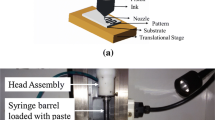Abstract
In-mold electronics (IME) is a novel manufacturing technology which combines printed electronics and film insert molding to produce electronics-integrated plastic components. Basically, the IME process includes printing, thermoforming, and injection molding. During the thermoforming process, the printed circuit undergoes deformation which results in a variation of the electrical resistance of the circuit, and, therefore, the thermoforming process is one of the important processes which determine the performance of the IME product. In this regard, this study aims to investigate the details of the resistance variation based on the deformation of the printed circuit during the thermoforming process. The deformation of the printed circuit is characterized experimentally and numerically, while a regression model is constructed to describe the relationship between deformation and electrical resistance of the circuit. Then, the electrical resistance distribution of the circuit after the thermoforming process is predicted based on the numerical results and the regression model, which is compared with experimental data. The effect of geometrical parameter is also investigated both experimentally and numerically.














Similar content being viewed by others
References
Matsuhisa N, Kaltenbrunner M, Yokota T, Jinno H, Kuribara K, Sekitani T, Someya T (2015) Printable elastic conductors with a high conductivity for electronic textile applications. Nat Commun 6:1–11. https://doi.org/10.1038/ncomms8461
Chen SC, Li HM, Huang ST, Wang YC (2010) Effect of decoration film on mold surface temperature during in-mold decoration injection molding process. Int Commun Heat Mass Transf 37:501–505. https://doi.org/10.1016/j.icheatmasstransfer.2010.01.005
TactoTek IMSE Production (n.d.) https://tactotek.com/this-is-imse/imse-production/
DuPont In-Mold Electronic Technology (n.d.) https://www.dupont.com/products/in-mold-electronic-technology.html
Gill M, Gruner A, Ghalib N, Sussman M, Avuthu S, Wable G, Richstein J (2018) Analysis of the design variables of thermoforming process on the performance of printed electronic traces. In: IPC APEX EXPO Proc., St. Petersburg, Florida, USA
Sala G, Landro DL, Cassago D (2002) A numerical and experimental approach to optimise sheet stamping technologies: polymers thermoforming. Mater Des 23:21–39. https://doi.org/10.1016/S0261-3069(01)00037-1
Ghobadnam M, Mosaddegh P, Rejani MR, Amirabadi H, Ghaei A (2015) Numerical and experimental analysis of HIPS sheets in thermoforming process. Int J Adv Manuf Technol 76:1079–1089. https://doi.org/10.1007/s00170-014-6329-y
O’Connor CPJ, Martin PJ, Sweeney J, Menary G, Caton-Rose P, Spencer PE (2013) Simulation of the plug-assisted thermoforming of polypropylene using a large strain thermally coupled constitutive model. J Mater Process Technol 213:1588–1600. https://doi.org/10.1016/j.jmatprotec.2013.02.001
Taylor CA, Delorenzi HG, Kazmer DO (1992) Experimental and numerical investigations of the vacuum-forming process. Polym Eng Sci 32:1163–1173. https://doi.org/10.1002/pen.760321613
Chang YW, Cheng JH (2013) Numerical and experimental investigation of polycarbonate vacuum-forming process. J Chin Inst Eng 36:831–841. https://doi.org/10.1080/02533839.2012.747059
Ayhan Z, Zhang QH (2000) Wall thickness distribution in thermoformed food containers produced by a Benco aseptic packaging machine. Polym Eng Sci 40:1–10. https://doi.org/10.1002/pen.11134
Chen SC, Huang ST, Lin MC, Der Chien R (2008) Study on the thermoforming of PC films used for in-mold decoration. Int Commun Heat Mass Transf 35:967–973. https://doi.org/10.1016/j.icheatmasstransfer.2008.04.008
Kim G, Lee K, Sungsu K (2009) Prediction of the film thickness distribution and pattern change during film insert thermoforming. Polym Eng Sci 49:2195–2203. https://doi.org/10.1002/pen.21467
Mosallaei M, Jokinen J, Kanerva M, Mäntysalo M (2018) The effect of encapsulation geometry on the performance of stretchable interconnects. Micromachines. 9:645. https://doi.org/10.3390/mi9120645
Suikkola J, Björninen T, Mosallaei M, Kankkunen T, Iso-Ketola P, Ukkonen L, Vanhala J, Mäntysalo M (2016) Screen-printing fabrication and characterization of stretchable electronics. Sci Rep 6. https://doi.org/10.1038/srep25784
Larmagnac A, Eggenberger S, Janossy H, Vörös J (2015) Stretchable electronics based on Ag-PDMS composites. Sci Rep 4. https://doi.org/10.1038/srep07254
Lu N, Wang X, Suo Z, Vlassak J (2007) Metal films on polymer substrates stretched beyond 50%. Appl Phys Lett 91. https://doi.org/10.1063/1.2817234
Abbasi S, Carreau PJ, Derdouri A (2010) Flow induced orientation of multiwalled carbon nanotubes in polycarbonate nanocomposites : rheology , conductivity and mechanical properties. Polymer. 51:922–935. https://doi.org/10.1016/j.polymer.2009.12.041
ANSYS Polyflow (n.d.) https://www.ansys.com/products/fluids/ansys-polyflow
Giacomin AJ, Mix AW, Mahmood O (2010) Sag in thermoforming. Polym Eng Sci 47:21–25. https://doi.org/10.1002/pen
Bourgin P, Cormeau I, Saint-Matin T (1995) A first step towards the modelling of the thermoforming of plastic sheets. J Mater Process Technol 54:1–11. https://doi.org/10.1016/0924-0136(95)01910-3
Hsiao SW, Kikuchi N (1999) Numerical analysis and optimal design of composite thermoforming process. Comput Methods Appl Mech Eng 177:1–34. https://doi.org/10.1016/S0045-7825(98)00273-4
Chen S, Zhang S, Ruan F (2012) Numerical simulation of the pre-drawing and air-bulging thermoforming process for in-mould decoration films. J Comput Theor Nanosci 9:1477–1480. https://doi.org/10.1166/jctn.2012.2227
Van Mieghem B, Desplentere F, Van Bael A, Ivens J (2015) Improvements in thermoforming simulation by use of 3D digital image correlation. Express Polym Lett 9:119–128. https://doi.org/10.3144/expresspolymlett.2015.13
Toth G, Bata A, Belina K (2017) Polycarbonate melt shear viscosity in wide range shear rate. IOP Conf Ser Mater Sci Eng 175. https://doi.org/10.1088/1757-899X/175/1/012056
Barnes HA, Roberts GP (1992) A simple empirical model describing the steady-state and extensional viscosities of polymer melts. J Non-Newtonian Fluid Mech 44:113–126
Kommoji S, Banerjee R, Bhatnagar N, Ghosh AK (2015) Studies on the stretching behaviour of medium gauge high impact polystyrene sheets during positive thermoforming. J Plast Film Sheeting 31:96–112. https://doi.org/10.1177/8756087914538443
Funding
This work was financially supported by the Yeungnam University Research Grant Program 2018.
Author information
Authors and Affiliations
Corresponding author
Additional information
Publisher’s note
Springer Nature remains neutral with regard to jurisdictional claims in published maps and institutional affiliations.
Rights and permissions
About this article
Cite this article
Gong, Y., Cha, K.J. & Park, J.M. Deformation characteristics and resistance distribution in thermoforming of printed electrical circuits for in-mold electronics application. Int J Adv Manuf Technol 108, 749–758 (2020). https://doi.org/10.1007/s00170-020-05377-9
Received:
Accepted:
Published:
Issue Date:
DOI: https://doi.org/10.1007/s00170-020-05377-9




